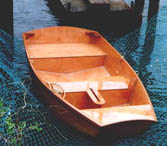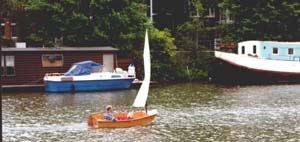
Here is a picture of a D4 and the same boat leisurely cruising on an Amsterdam canal. Both pictures are by Abel Praamstra, Amsterdam (pictures copied from Mertens Goossens site)

Building a stitch and glue dinghy
Building a wooden boat is an exciting and rewarding experience. If you are not well prepared for what is coming however, it can also turn into a frustrating experience (many amateur boatbuilders know this). I believe that the following requirements, in order of importance, must be satisfied if you want to enjoy building your own boat. You surely can work out something with less, but it is likely to take the fun out of boatbuilding.
| - You must have enough money (no big deal for a dinghy) |
| - You must have enough time (no big deal for a dinghy) |
| - You must have a suitable place, preferably closed (no big deal for a dinghy) |
| - Your spouse (if you have one) must have proven patience (big deal even for a dinghy) |
| - You must have the necessary tools (no big deal for a dinghy) |
| - You must have some basic woodworking skills (no big deal for a dinghy) |
Right at the outset, you must choose your project taking the above factors into consideration. Starting with a dinghy is the most appropriate because it is cheap, requires little time and space to build, and it doesn't matter if you make a couple of errors while cutting or glueing wood. In addition, it helps test your skills, patience and determination and possibly saves you from wasting time and money in case you want to start by building something more spectacular. Last but not least, you'll need a dinghy anyway, even if you build a bigger boat in the future.
Next thing to do is to determine the technique to build the boat. Of course, only wooden boats are being considered here. There are many wooden boatbuilding techniques like lapstrake, carvel, and strip planking. Most of these (except possibly strip-planking) require more than entry-level woodworking skills and almost all of them require frame molds. Classical plywood construction (in which you cut the plywood panels, nail stringers along the seams and fasten the panels to the stringers) is also an option. One particularly attractive technique is the stitch and glue method, in which you cut plywood panels to shape, and fasten these together using epoxy resin. Provided your plan is good enough, this method generally yields boats with more beautiful lines than the boxy shapes you usually obtain using the classical plywood construction method.
After reading a couple of books on the subject, I was convinced that I could build a boat using this method. I recommend Sam Devlin's wonderful book on the stitch and glue technique (Devlin Wooden Boat Builders). Harold "Dynamite" Payson's books (HH Payson&Co.) also offer some interesting ideas and shortcuts as well as a few of Phil Bolger's small boat plans. The books can be ordered from Amazon.com, or from the above sites. Both Devlin and Dynamite also sell boat plans.
Plans for a sailing dinghy are cheap (about $20), and usually available online. In addition to the above sites, I recommend Mertens-Goossens Boat Plans OnLine Home Page and Glen-L marine designs for boat plans. Of course, you can find plans for larger boats in these sites and not only stitch and glue (or wooden for that matter). If you need to do more research on boat plans before you decide on one, check the approppriate section of The Mother of All Maritime Links. This site contains virtually everything (I mean it!) related to the marine world.
Devlin's site and the Mertens-Goossens site also have sections describing the stitch and glue method in some detail. So, I'm going to skip the details of the method. As for the D4 dinghy that I chose, plans are available for free from the Mertens-Goossens site. The following factors influenced my decision in choosing the D4:
 |
Here is a picture of a D4 and the same boat leisurely cruising on an Amsterdam canal. Both pictures are by Abel Praamstra, Amsterdam (pictures copied from Mertens Goossens site) |
 |
| - She is a beautiful boat, |
| - She can be built in sailing and rowing versions and even a small outboard can be attached, |
| - Some people say she performs at least as good as an optimist, |
| - Many have been built around the world (The plans have been downloaded more than 200,000 times), |
| - Plans are for free! What more could you ask? |
This design is called a "pram" dinghy. I don't know what that means but I think it has to do something with the presence of the bow transom, an unusual sight in Turkish waters. The presence of the bow transom allows more space in the boat which is important for such a small design. On the other hand, if the boat is loaded and the bow is buried in the water (which, in a boat of this size means either you have a passenger on board or shift your weight towards the bow a little), it is detrimental to speed. But after all, when flotation is enough for an amateur builder who cares about speed?
After downloading the plans, I built a 1:3 scale model of the boat using 2 mm thick cardboard. I had two reasons to do this: First, I had to make sure that the dimensions on the plans are correct. If you learn that there is an error in the plans after cutting the panels, your boatbuilding experience will probably not be much fun. Fortunately, the plans turned out to be allright. The second reason is to get a feeling of the stitch and glue method. Stated in another way, how the flat panels, when assembled together, make such beautiful curves. Although it is not that difficult to visualize this, observing it is something else and I can assure you that it is fascinating.
When everything turned out to be allright, I bought the plywood and lumber and started the project in my front yard. One final word, boatbuilding, especially building a small boat, is a family affair, or at least it is supposed to be. If you don't believe me check Richard's D4 pages and Beymer family's D4 pages both of which describe building of their D4's. My family also contributed to this project and I am grateful to them at least for one thing if nothing else: For two months they calmly accepted their living quarters to be cluttered with plywood sheets, 3.5 meter long boards, hundreds of small pieces of wood, all kinds of tools, strange chemicals and sawdust that kept creeping in. Some of these hang around even to this day. The neighbors' behaviour was also exceptional. To them a boat, however small, being built from plywood in someone's yard in Ankara was comparable to Martians camping at the very same spot and they followed all the stages with genuine interest. I would also like to thank everybody for tolerating the substantial amount of noise I generated.
Because the following material contains many pictures, I have arranged them into 4 separate sections. Click on the thumbnails to enlarge the pictures. My observations which can be helpful to the first time builder are included either inline or as separate links in the appropriate sections.
| 1. Cutting the panels and stitching |
| 2. Glueing and glassing |
| 3. Bits and pieces |
| 4. Painting |
| 5. Epilogue |